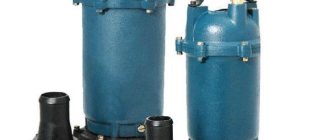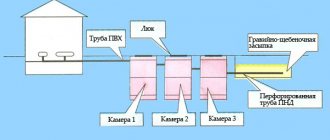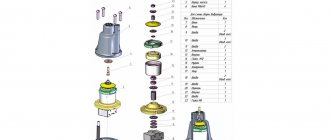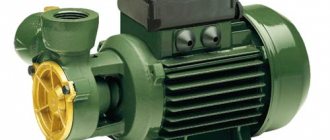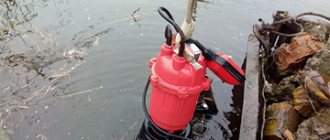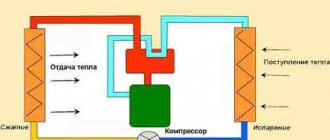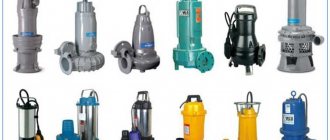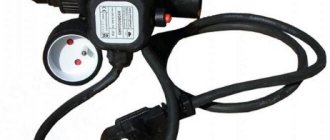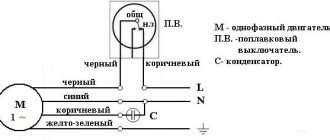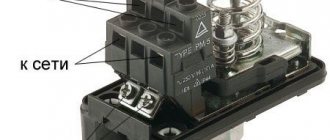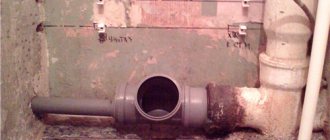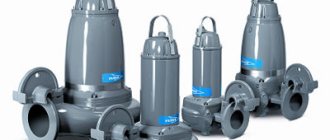To pump out contaminated liquid, two types of pumps are used - drainage and fecal. The difference between these units is that drainage units are capable of pumping clarified water with small inclusions of sand, silt, and debris, while fecal pumping equipment is designed for viscous, thick liquid, which must be crushed and delivered to a storage tank. A fecal pump with a grinder for cesspools is a necessary element of an autonomous sewage system, without which stable operation of the system is not possible.
Purpose of fecal pumps with grinder
Scheme of a fecal pump with a grinder for a toilet bowl
The need for a fecal pump arises when the owner is faced with the problem of cleaning a cesspool, because large garbage, food products, and human waste get into it. There is a way out - shake the mixture in a septic tank, pump it out, then add water again and pump it out again. But this is a very labor-intensive process, and also unpleasant. The sediment at the bottom of the septic tank tends to compact. Only a grinder on fecal equipment can cope with solid contents.
If silt collects at the bottom of the storm sump, the drainage pump may jam, since this is a very thick liquid; in any case, it must be crushed during pumping. There is no grinding function in drainage units.
Installation and connection of a submersible fecal pump
Most often, a drain well is installed on the street, at some distance from the house. Sometimes it is placed in the basement. The volume of the receiving well may vary. This indicator depends, first of all, on the number of people living in the house. For 3-4 people, a well with a depth of 1 m and a diameter of 70 cm will be quite sufficient. Its walls can be made, for example, of plastic. In this case, a ready-made version of the well with pipes is purchased. On the street, sewer receiving wells are often made of concrete rings.
In any case, the installation principle of the unit will be the same. The installation diagram for this type of fecal pump is as follows:
- A pump is installed at the bottom of the well. Most models are equipped with special metal supports that provide the required clearance between the unit and the intake hole.
- An intake pipe with a diameter of 2-2.5 inches is connected to the pump.
- A check valve is pre-cut into it. A shut-off valve must be installed behind it.
Principle of operation
A fecal pump with a grinder for a toilet works according to the following scheme:
- The liquid is sucked into the working chamber.
- The cutting mechanism is located at the inlet, that is, the waste enters the pipe already crushed to small particles.
- The flow picks up speed and, under pressure, enters the pipes through which it is discharged outside.
When purchasing a unit, you need to pay attention to the labeling. The presence of certain letters determines what kind of waste and what size the device can pass through:
- if the abbreviation contains only numbers, the equipment can pump and grind waste up to 5 mm in diameter;
- if the letter “f” is present, the device crushes and pumps long fractions - rags, garbage - with a diameter of up to 35 mm;
- if there is a letter “n”, the unit is capable of operating in aggressive liquids for a long time, all its parts are made of appropriate materials.
Similar structures are installed on cesspool trucks, which are called to empty autonomous septic tanks.
Device structure
Fecal pump device
A distinctive feature of fecal pumps is their wide sleeves, capable of passing debris up to 5–7 cm in diameter.
The internal design is somewhat more complex than that of conventional pumping equipment. Its components:
- rotor;
- stator;
- frame;
- working shaft;
- suction pipe depending on the model;
- Working wheel;
- oil chamber for cooling the unit if it is not submersible;
- small volume storage tank;
- in some models there is a float to control the liquid level, which turns off the device if necessary.
There are various modifications that are used in home sewage systems. If you connect a sewage pump that will forcefully transport wastewater into a septic tank, there is no need to take into account the slope of the pipes when laying them. The unit is capable of moving masses both vertically and horizontally.
The equipment operates from the mains, so it is advisable that there are no voltage drops. For this purpose, stabilizers are installed, which contributes to a long service life without the need for repairs.
Types of fecal pumps
There is no specific classification of fecal pumps, since in each specific situation it is necessary to select units based on the following parameters:
- performance;
- duration of working hours;
- temperature regime, since some models are capable of operating at high temperatures, while others are not suitable for this;
- design features - with or without a chopper.
By design, fecal pumps are:
- submersible;
- semi-submersible;
- superficial.
Submersible
Semi-submersible pump
Surface
Submersible models are designed for constant exposure to an aggressive environment, so the most durable materials are used for their production - stainless steel, cast iron, shockproof plastic. A submersible fecal pump with a grinder for a summer residence makes less noise, since it is located in a layer of liquid. They may have a chopper, but there are models without it.
In semi-submersible structures, the working unit is located in the upper layer of the drains. This resembles a float, the lower part of which sucks in liquid and thus raises it to the surface. Materials for manufacturing: aluminum or plastic. Models are less durable and susceptible to mechanical damage. They make noise when working.
Surface devices do not come into contact with waste - they reach the surface through a hose or pipe. In terms of power, the pumps are significantly weaker than the two previous models and can pump out waste no deeper than 15 m. They are purchased in cases where it is necessary to change the location of the device. For example, to periodically empty a cesspool, clean a home pond, or pump out water from the basement after spring floods. For permanent installation, it is necessary to prepare a separate room with thermal insulation so that the device does not freeze in winter. The device also makes a lot of noise, so the room is also soundproofed. Surface pumps are not equipped with a grinder and are therefore not suitable for pumping cesspools containing large particles, rags and debris.
Fecal pump: what to remember when using it
Many people have a vague idea about fecal pumps. Meanwhile, it is thanks to them that you can independently clean the sewer, remove and dispose of wastewater. Therefore, knowledge of the features of their use will allow you to “enlist” the help of the pump for a long time when emptying the sewer and ensuring cleanliness and order in the house and on the site.
Choosing the right model
Since a wide range of similar equipment is offered for sale today, you should wisely choose the optimal model. You can read about how to approach the process of choosing a fecal pump option in the following article on our website.
For example, options for a fecal pump equipped with a grinder will have a higher price. But at the same time they are more powerful and reliable. And their service life is guaranteed by the manufacturer as one of the longest.
Options with a large power reserve are suitable for private homes with a large family. Their full depletion period is much longer than that of models with low power.
You can buy a drainage and fecal pump with characteristics that will best and fully satisfy the requirements from various manufacturers. However, it is better to choose companies that have already proven themselves in the market and have a positive reputation and good reviews. In particular, the pedrollo fecal pump is considered one of the most reliable and powerful. And the grundfos fecal pump offers customers a wide choice at a variety of prices.
Process of use: follow simple rules
Like any other device, fecal pumps require careful handling. Following the instructions in the instructions will help you avoid possible breakdowns. And regular preventative maintenance will prevent possible major repairs or even replacement of the pump.
To maintain all the qualities and capabilities of the selected pump, the following actions should be performed regularly:
- cleaning after each time the pump is used;
- Before pumping out wastewater, it should be liquefied. For this purpose, special products containing active bacteria are used. They “convert” the solid fraction of wastewater into liquid and thereby facilitate the operation of the pump;
- Regardless of the type and type of the selected model, it is necessary to assemble, install and use the unit in accordance with the requirements of the attached instructions.
The body of fecal pumps is usually made of durable material. He must resist the aggressive environment in which he must work. This primarily applies to submersible models. They are installed directly into wastewater. Timely monitoring of the condition of the case, its integrity and the absence of traces of rust will allow you to maintain the functionality of the entire system for a long time.
Regular Maintenance
With regular preventative maintenance, the device will work as long and efficiently as possible. A submersible fecal pump with a grinder will require checking the condition of both the housing and the blades of the cutting mechanism. This will allow you to detect deterioration in its operation in time and carry out minor repairs in a timely manner.
For maintenance and repair, it is recommended to contact only specialized companies. It is there that the craftsmen have sufficient practical experience to adjust the operation of the device. And also avoid the need for major and expensive repairs.
Sewage pump maintenance should be performed every year. The oil is changed and the condition of the gasket is checked.
Operating the fecal pump correctly
Fecal pumps for sewage in a private home must be used correctly.
Below are the most important points when operating this type of equipment:
- Submersible pumps can only be turned on after the unit is immersed in water;
- The float marks the water level. And in the event of a significant drop in the water level, the unit automatically turns off;
- The equipment can operate from both single-phase and three-phase networks.
When removing the device from the cesspool, do not pull on the electrical cord. The pump should be carried using the handles specially designed for this purpose.
You won't miss any of our content if you subscribe. It’s very easy to sign up: just enter your e-mail in the form under this article and click on the “Subscribe to newsletter” button. And you will always be aware of our publications, receiving them directly in your inbox!
Criterias of choice
When choosing a device for household needs, it is necessary to pay attention not only to the brand of the product, but also to the presence of symbols in the abbreviation so that the equipment meets all the requirements.
- Power. If the septic tank is located deep, surface models will not cope with rising to such a height.
- Availability of knives. Equipment without a grinding function is not suitable for wastewater from a home or street toilet.
- Operating mode at high temperatures. Such units are mainly purchased for industrial enterprises. At home, high temperatures are not expected.
- Marking. Based on the size of large particles that will have to be crushed and pumped, the device should indicate that it is designed for such work.
The type of construction is taken into account when it is planned to use the model only permanently or for moving. Submersible fecal pumps with a grinder are considered the most powerful and durable equipment, but they are always used permanently. Disassembling and moving such a device is quite problematic.
The duration of operation is determined by the amount of time that the device will pump wastewater. This parameter is important if you plan to empty sewage pits of waste on a daily basis. Constant work is carried out on domestic livestock farms, where a certain amount of waste is collected every day to be disposed of.
Carrying out the necessary calculations
All devices are designed for a 220 V power supply, but it is necessary to calculate that you will need to ground for your own safety, as well as connect a stabilizer, which will also require financial expenses.
The first parameter that is taken into account when selecting equipment is the depth of the septic tank. For a summer cottage, 500 W is enough, which will allow you to pump about 150 l/minute. For a private home you will have to buy a more powerful model. If the depth is from 5 to 8 meters, a 1100 W pump will do. This device pumps a wastewater volume of 650 liters in a minute.
The height of the water column for viscous liquids is different from water pumps, where 1 meter vertical corresponds to 10 meters horizontally. Here the ratio is ¼ meters, that is, 1 vertical meter equals 4 horizontal meters.
It is not recommended to save money and buy submersible models made of plastic. Steel is more reliable and will last longer.
Semi-submersible
A distinctive feature of this device is considered to be a special system, which is equipped with a float mechanism; subsequently, its operation, the water receiving and working parts are located below the sewage level, while the electric motor and other components are above. As a result, the cost of protecting the housing from leaks is reduced and the service life is increased. Another important feature that this fecal sewer pump has is the absence of knives, but at the same time it pumps inclusions with a diameter of up to 15 mm.
Semi-submersible units have fairly high power and can handle large volumes of feces and sewage. As a rule, they are equipped with a centrifugal pressure injection system, which ensures reliability and performance.
Installation of a fecal pump consists of connecting it to plumbing systems; in the working environment it is “free floating”. In addition, it is necessary to take into account the danger of short circuits and take special responsibility when connecting to the electrical network. Such devices, as a rule, are installed in houses where the bulk of the wastewater consists of feces and liquids, since the absence of a cutting mechanism will not protect the sewerage system from the ingress of unwanted fragments and objects.
Installation features
If you plan to use a fecal pump only depending on the season, there is no point in buying expensive models and installing them permanently. It’s another matter if he works permanently in a private home. You can install according to two schemes:
- A concrete platform is made at the bottom, onto which the body of the product is fixed. Getting such a structure is problematic, since you will have to call divers-plumbers if repairs are needed.
- It is much more practical to install the pump so that you can get it out yourself if necessary. Usually a strong nylon cord or chain is attached to lift the pump from the depths. The disadvantage of this method is that it uses corrugated pipes, which have to be changed frequently due to contamination. Cleaning them is extremely unpleasant.
Sometimes waste needs to be pumped out of a common septic tank, but it is located in a place where a sewage truck cannot reach, so they equip an intermediate pit into which the waste is pumped using a pump and then order a machine with a regular hose. This is cheaper than looking for a sewer truck with a long hose, which costs half the cost of a mid-price sewage pump.
Fecal pump and its storage
The fecal pump should be stored completely cleaned and dried. This will avoid the possibility of traces of corrosion appearing on it.
It is better to store the fecal pump in a dry room with good ventilation. With regular maintenance, proper operation and use in strict accordance with the requirements of the attached instructions, the selected model of fecal pump will serve for a long time and reliably.
Operation and Maintenance
In order to repair equipment less often, it must be selected correctly and not used in situations for which it is not intended. You cannot install a fecal pump without a grinder in a cesspool with a particle diameter greater than 35 mm. The pump will not hold up and will burn out.
In the presence of voltage drops, any units fail faster, so it is better to organize the power supply so that the voltage is constant.
To repair pumps, it is better to call professionals, as they can correctly determine the cause of the breakdown and give recommendations for further operation.
Advantages and disadvantages of fecal pumps with a grinder
The advantages of the model are determined by its design and operating conditions. Submersible models are capable of lifting liquid from great depths; if there is a control float, they operate in automatic mode; additional cooling is not required, since the device is located in the waste layer and does not overheat and does not make noise. There are practically no disadvantages if expensive equipment made from durable materials is purchased.
Advantages of semi-submersible models:
- low cost;
- repairs are cheaper;
- no need for waterproofing.
Disadvantages - shallow depth, inability to pump large particles, since it is not possible to install a grinder.
The disadvantage of surface fecal pumps is cavitation: if the depth is greater than that indicated in the instructions, air gets into the liquid and the motor stops or burns out, so they are used only for shallow septic tanks. Also, surface equipment is bulky and noisy. The advantage is mobility, the ability to be used for all household needs.
Rating and prices
Prices for fecal pumps for pumping out sewerage in a private house depend on the power and height of liquid lift, as well as on the material from which the device is made. Semi-submersible and surface units are cheaper. The most expensive are imported submersible structures.
The most expensive appliances are made of stainless steel and cast iron. Shockproof plastic is cheaper. The scope of application can be different - the more versatile the equipment, the more expensive it is. If, for example, the house has a hot water bath, you will have to buy an expensive fecal pump with a hot water grinder. Such a device can work with liquids whose temperature reaches 90 degrees.
The most popular models are pumps from German and Italian manufacturers - Pedrollo, Calpeda, Grundfos. The equipment operates without repair for about 10 years; there are service centers throughout the country where you can buy spare parts or invite a technician for service.
Specifications
The table shows average data for common models.
| Characteristic | Minimum | Greatest |
| Productivity, l/min. | 60 | 250 |
| Pump power, W | 250 | 900 |
| Lifting height, m | 3,5 | 10 |
| Horizontal range, m | 75 | 120 |
| Number of inlet pipes, pcs. | 1 | 5 |
| Suction fluid temperature, 0C | 35 | 75* |
* - short-term, up to 3 minutes, 900.
A sewage pump is selected taking into account the amount of wastewater, its characteristics, as well as the remoteness of the connection point. Pumps not designed for pumping out hot liquids will quickly fail if used to pump out high-temperature wastewater. Low-power ones will not be able to lift wastewater to great heights.
With low productivity, pumping will take a very long time, and some of the wastewater will begin to stagnate in the pipes. Conversely, a very efficient pump will pump out the tank faster than it fills. Hence the frequent switching on, which will lead to early failure of the electric motor.
Therefore, the choice of pump must be made taking into account knowledge of all the data on the quantity and nature of wastewater and not chasing the most powerful ones.
The most famous pump manufacturers are: Grundfos, SFA, JEMIX, UNIPUMP, Termica, AquaLiv.
